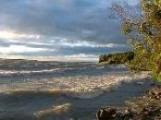Sampling art in Simcoe County
Sampling art in Simcoe County
Paul Johnson, whose studio is between Barrie and Orillia, specializes in Spanish pottery.
Autumn colour and art seem to flow naturally together on Thanksgiving artist studio tours.
Here's an idea for a holiday weekend expedition. Take one of the many tours that will be featured across Ontario and you'll see lots of flaming autumn foliage and scenic landscapes. You'll also meet many friendly talented artists, visit the studios and homes they have created, view their work and perhaps do some early holiday shopping at bargain prices.
For this Thanksgiving, I'm recommending the 23rd annual Simcoe County Images tour, from Friday to Monday Oct. 6 to 9. It showcases 22 studios and 42 artists in the forest, farm and lake region between Lake Simcoe, Georgian Bay, Barrie and Orillia.
The whole tour is free. You don't have to buy any passports or spend any money. If you wish, you may drop a food or cash donation to the Barrie and Orillia food banks at any one of the studios.
You can pick up an excellent colour brochure with pictures, maps and info about the artists at Ontario Travel Centres, local chambers of commerce and many regional retail stores. You can also log onto images-studio-tour.com or call tour coordinator Hartley Woodside at 705-728-3691.
I don't have space to write about all the fascinating artists on this tour. They range from basket makers, coin designers and stone sculptors to landscape painters.
I picked out one at random to visit. He turned out to be a potter, Paul Johnson, who lives and works on Sideroad 15/16 of Oro-Medonte, just off Hwy. 11 between Barrie and Orillia.
Friendly and fiftyish, Johnson was born in Hamilton, had Canadian artist Robert Bateman as a high-school teacher and attended the University of Windsor. Johnson then toured Europe, where he became interested in Spanish pottery and finally ended up at Georgian College, Barrie. Here, he fell in love with working on a potter's wheel and, thanks to a mortgage loan from a farmers' credit union, was able to establish a home and studio.
For 25 years he has been happily making pottery,selling it at craft shows and teaching the potter's art.
After watching a bowl appear under his hands on his potter's wheel, Johnson had me in an apron, my hands covered with muddy water, and seated at the wheel where I experienced the magic of shaping a piece of pottery.
Paul makes a wide variety of beautiful and functional stoneware. I didn't really need another piece of pottery but couldn't resist buying a lovely little blue-glazed bowl ($9.) for cereal. I admired many bowls, platters, mugs, lamps and teapots and one big mural that was priced at $1,400.
You can visit Paul any day and pick up one of the tour brochures. It's a good idea to phone first, 705-487-2581.
If you're looking for lodging, I can recommend Inn The Woods B&B, run by Bob and Betty Shannon. Contact innthewoodsbandb.com or 1-800-289-6295.



